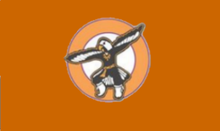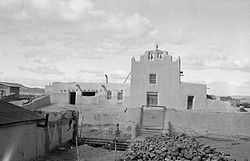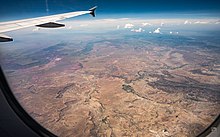This article includes a list of general references, but it lacks sufficient corresponding inline citations. (December 2013) |
 Pueblo of Laguna symbol | |
| Total population | |
|---|---|
| 6,758 (2010)[1] | |
| Regions with significant populations | |
| Languages | |
| Keresan language, English language | |
| Religion | |
| Traditional tribal religion, Christianity (Roman Catholicism and other) | |
| Related ethnic groups | |
| Acoma Pueblo, other Keres people (Cochiti Pueblo, San Felipe Pueblo, Santo Domingo Pueblo, and Zia Pueblo) |
Laguna Pueblo | |
 Laguna Mission | |
| Nearest city | Albuquerque, New Mexico |
|---|---|
| Coordinates | 35°1′8″N 107°23′04″W / 35.01889°N 107.38444°W |
| Area | 108 acres (44 ha) |
| Built | 1699 |
| Architectural style | Pueblo |
| NRHP reference No. | 73001154[2] |
| NMSRCP No. | 228 |
| Significant dates | |
| Added to NRHP | June 19, 1973 |
| Designated NMSRCP | December 30, 1971 |
The Pueblo of Laguna, New Mexico (Western Keres: Kawaika [kʰɑwɑjkʰɑ]) is a federally recognized tribe of Native American Pueblo people in west-central New Mexico, near the city of Albuquerque, in the United States. Part of the Laguna territory is included in the Albuquerque metropolitan area, chiefly around Laguna's Route 66 Resort and Casino. The name, Laguna, is Spanish (meaning "small lake") and derives from the lake on their reservation. This body of water was formed by an ancient dam that was constructed by the Laguna people. After the Pueblo Revolt of 1680–1696, the Mission San José de la Laguna was erected by the Spanish at the old pueblo (now Old Laguna) and finished around July 4, 1699.

- ^ 2010 Census American Indian and Alaska Native Summary File - Pueblo of Laguna alone (H45)
- ^ "National Register Information System". National Register of Historic Places. National Park Service. July 9, 2010.

